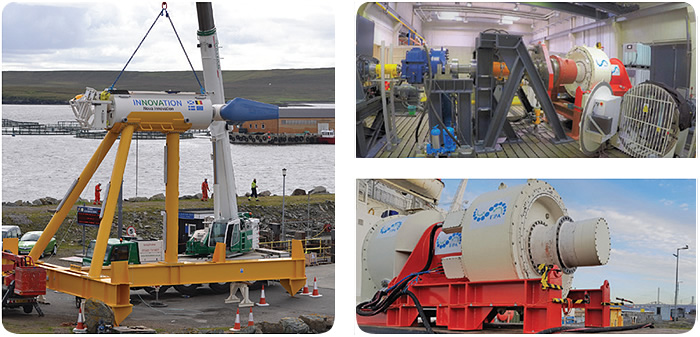Significant progress is being made with an innovative pan-European project which will accelerate commercialisation and reduce the cost of tidal energy production.
The EU-funded TiPA project has entered its sub-sea testing phase in the North Sea after two years of developing the new direct drive subsystem. The subsystem will be used in tidal turbines to convert energy into electricity more efficiently.
The new direct drive Power Take-Off (PTO) replaces the conventional gearbox and generator system and allows tidal energy to be turned into electricity more effectively. Testing shows the new device can significantly reduce the cost of tidal energy production.
The project is led by Nova Innovation and involves a consortium of partners including the University of Edinburgh, SKF, TU Delft, RWTH Aachen University, Siemens and Wood.
THE IMPACT OF TIPA
The TiPA project is an important part of the development pathway laid out by Nova Innovation to reduce the levelised cost of tidal energy, known as LCOE. Analysis by the University of Edinburgh showed that the project has achieved an LCOE reduction of 29%.
Nova Innovation Project Manager Seumas MacKenzie said: "These findings exceed the project target of a 20% reduction and demonstrate a significant improvement in lowering the cost of tidal energy."
"Real progress has been made since the project kicked off in 2016. In September 2018, the PTO completed 3 months of onshore testing at RWTH Aachen University, where the performance, reliability and survivability of the PTO were rigorously assessed."
“Subsea testing will be completed soon, the results of which are being analysed by the consortium to establish the next steps in the PTO design and commercialisation."

CATCHING THE TIDE
The TiPA project is an important part of Nova Innovation's wider project portfolio. As part of the separate D2T2 project, Nova is building a commercial demonstrator of a tidal turbine using direct drive technology with a target of reducing LCOE by 30%.
Additionally, through the EnFAIT project, Nova is doubling the size of its Shetland Tidal Array to six turbines. In a world first, the layout of the turbines will be re-arranged to enable array interactions and optimisation to be studied for the very first time at an operational tidal energy site.
Nova Innovation CEO Simon Forrest added: "By successfully delivering our project portfolio, Nova is proving in a real-world environment that LCOE reductions are being achieved, moving tidal energy towards commercial reality and emphasising that tidal energy, as a global mainstream renewable technology, is no longer a matter of "“if" it happens, but simply "when".
This project has received funding from the European Union's Horizon 2020 research and innovation programme under Grant Agreement No. 727793.